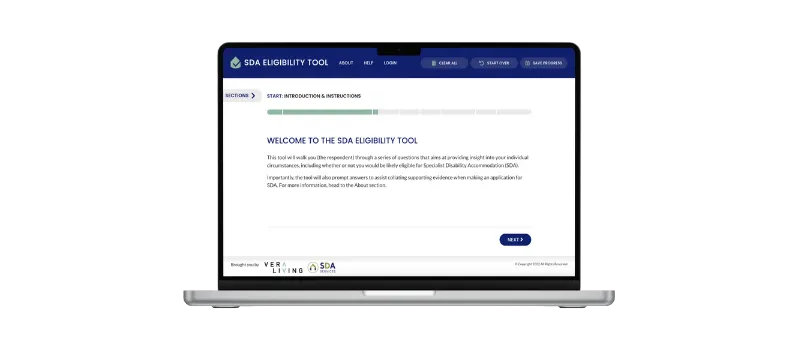We're here to help
Understanding SDA
Specialist Disability Accommodation (SDA) is a type of housing funded by the NDIS for people with functional impairment or high support needs. SDA homes are designed with features that support different physical, cognitive, and sensory needs, while enabling choice and control over the way you live and receive support.
Is SDA The Right Housing Response for You?
If you require high levels of person-to-person support and your current home doesn’t meet your needs, SDA housing may be an option to explore.
Currently, there are four SDA design categories that cater to different support needs:
-
Improved Liveability
“I require a high amount of person-to-person assistance and a home that can support my sensory and cognitive care needs”
You may benefit from living in a home that features:
- Living spaces that facilitate line of sight support;
- Design elements which support a range of sensory, physical or cognitive abilities;
- Specialised lighting design which responds to sensory stimulus; and
- Features to enable high levels of person to person supports as chosen by you.
-
Fully Accessible
“I require a high amount of person-to-person assistance and a home that can support my physical and mobility care needs”
You may benefit from living in a home that enables:
- Design elements that cater to physical and mobility support needs – the need for a housing response that supports some level of physical impairment e.g. widen doorway to support wheelchair access, handrails, modified bathroom etc;
- The option of automation of housing features e.g. automated blinds and doors etc;
- The option of accessible features such as height adjustable kitchen benchtops and cooking facilities; and
- High levels of person to person supports as chosen by you.
-
High Physical Support
“I require a high amount of person-to-person assistance and a home that is completely accessible with technology solutions that facilitate increased independence”
You may benefit from living in a home that enables:
- The inclusion of all features of a Fully Accessible home, plus;
- Independence for someone with significant physical and mobility support needs;
- Independence for someone who requires the use of a wheelchair to mobilise;
- Complete accessibility throughout the home;
- Installation of a ceiling hoist;
- The use of assistive technology for heating and cooling, automation and communication; and
- High levels of person to person supports as you choose.
-
Robust
“I require a high amount of person-to-person assistance and a home that supports my behaviours of concern and keeps me and everyone else safe”
You may benefit from living in an SDA home that enables:
- All Features of an Improved Liveability home, plus;
- You, your guests and supports to feel safe and comfortable in your home, even at times when you require support in working through your communication (verbal or physical);
- You to live in an environment built from resilient materials that limit the chances of property damage, for example re-enforced walls, secure windows, soundproofing, laminated glass;
- Private, safe areas of the home where your guests or supports can move to, providing you space when you want it; and
- High levels of person to person supports as you choose.
-
Other Housing
Home modifications on an existing property
“I like where I live and am able to complete modifications to make this more suitable to my needs”Useful links:
Private rental
“I do not require any modifications or accessibility options in my house and have the money to rent privately”Useful links:
Subsidised Housing
“I do not require any modifications or accessibility options in my house however I require a home with reduce rent”Useful links:
- Queensland Government Homes and Housing
- New South Wales Government Housing
- Australian Capital Territory Government Housing
- Victoria Housing
- South Australian Housing Authority
- Government of Western Australia Housing Authority
- Northern Territory Government Department of Housing and Communities
- Department of Communities Tasmania
Home Ownership
“I am in a position to own my own home and make the changes needed to ensure my home supports my needs”Useful links:
Supported Independent Living (SIL) homes
“I do not require any modifications or accessibility options in my house but still require a place to live and face to face supports”Useful links:
Are you eligible for SDA?
The SDA Eligibility Tool is a simple and reliable way to understand whether you may meet the eligibility criteria for Specialist Disability Accommodation under the NDIS. Your answers help indicate if SDA may be considered a reasonable and necessary support in your NDIS plan. Use the online tool and start exploring your options today.
Find out if you're eligible
Use our tool for a free, accurate assessment — it takes less than 10 minutes.

The SDA Journey
Whether you’re just beginning to explore Specialist Disability Accommodation or ready to take the next step, these simple steps can help you plan with confidence.
-
1. Understanding SDA eligibility
I will – what you, or your trusted person need to ensure:
- Review my eligibility for NDIS funding against the measures listed in the NDIS access form;
- Ensure I have a housing goal in my NDIS plan;
- Complete an NDIS Home and Living Supports Request Form and submit it to the NDIA for review; and
- Contact Vera Living’s Tenant Journey Specialist to find out how they can support me throughout my journey.
Who – some key people to draw upon:
- Your Family and friends;
- Your Informal support network; and
- Your Support Coordinator.
When – a good timeline to work towards:
- 6-8 months from when you would like to move into your new home.
-
2. Engage with your Clinical specialist to plan a review of your housing
I will – what you, or your trusted person need to ensure:
- Work closely with my chosen Occupational Therapist to complete and submit my functional housing assessment report in line with the NDIS SDA guidelines.
Who – some key people to draw upon:
- Your Vera Living Tenant Support Specialist; and
- Your Occupational Therapist and/or clinical assessment team.
When – a good timeline to work towards:
- 5 months from when you would like to move into your new home.
-
3. Engage with your Support Coordinator to review housing options
I will – what you, or your trusted person need to ensure:
- Work closely with my Support Coordinator so they can:
- Complete a thorough housing options search to help me make the right choice;
- Complete my housing options report, identifying the most suitable housing for me;
- Submit a Change of Situation to NDIA which aligns with my SDA application; and
- Submit a completed SDA application to NDIA.
Who – some key people to draw upon;
- Your Vera Living Tenant Support Specialist;
- Your Support Coordinator; and
- Your Family and friends.
When – a good timeline to work towards:
- 4-5 months from when you would like to move into your new home.
- Work closely with my Support Coordinator so they can:
-
4. Find a home that aligns to your lifestyle and support needs
I will – what you, or your trusted person need to ensure:
- Work proactively with my NDIA planner, Vera Living Tenant Engagement Specialist, and other members of my support team to confirm my SDA eligibility; and
- Proactively engage interactive property tours, to find and select the home that best suits my lifestyle.
Who – some key people to draw upon:
- Your Vera Living Tenant Support Specialist;
- Your Support Coordinator;
- Other chosen Allied Health professionals; and
- Your Family and friends.
When – a good timeline to work towards:
- 4 months from when you would like to move into your new home.
-
5. Plan your move!
I will – what you, or your trusted person need to ensure:
- Engage with all of my key people to plan and implement a wholistic transition into my new home.
Who – some key people to draw upon:
- Your Vera Living Tenant Support Specialist;
- Your Support Coordinator;
- Other chosen Allied Health professionals; and
- Your Family and friends.
When – a good timeline to work towards:
- 1 month from when you plan to move into your new home.
We’re here to help
Get in touch with our friendly team to learn more about our homes and how we can support your goals.
